This article was first published on 220 Triathlon.com.
Which are the fastest deep section wheels? Let's find out!
Deep-section aero wheels offer some of the biggest speed gains you can find, along with your helmet and clothing. The difference between basic training wheels and the best of this group can be as much as four minutes in a 40km bike leg. In short, aero wheels are essential as soon as you switch from completing to competing.
- 10 of the best performance road tires lab tested
- Lab test: what causes brake rub - the wheels or the frame?
Super-deep wheels, such as the 70mm-plus hoops here, are specialist tools for racing on flat and rolling courses. While they’re much faster than standard wheels, they are slightly heavier than shallower carbon wheels and even the best of them get pushed around a bit on windy days.
Ideally, if you were racing on mixed terrain, you’d have a set of lighter mid-depth wheels for hillier events. For that reason, we have also included two mixed depth wheelsets with deeper rears and two mid-depth circa 65mm pairs to serve as more rounded options and to see if deeper is always faster.
As with any wheel test, we’re looking for speed, stability in crosswinds, effective all-weather braking and high lateral stiffness for handling and response. While speed is the priority here, braking performance and especially stability are key to ensuring that you can use your best wheels confidently regardless of the conditions.
The top brands have been working hard on stability and braking, with new rim shapes and brake tracks, so we were keen to see what progress they’ve made in our search to discover which are the best deep aero wheels.
How we tested
A lot went into this process. We spent a day at the University of Southampton’s wind tunnel gathering precise aero data at two yaw angles to simulate calmer and windier conditions.
Before that, we tested each wheelset on the road, racking up more than 2,000 miles, often in competition and in all weather, in a process that spanned six months. We used Michelin Power 4 Competitions as control tyres (except on the Mavics which come with specific tubs), running them all at 100/105psi and noting the inflated width measured with a caliper to see if it matches the rim and you can enjoy the rolling, comfort and grip benefits of a 25c tyre over a 23.
Every wheel was tested using the supplied brake pads and, of course, we weighed them all, too. On the road we studied stability, braking and stiffness, plus a subjective idea of speed, by riding hard on well-known roads and seeking out crosswinds. Your tester has extensive experience of this type of wheel as both a product tester and racer.
Wind tunnel testing
The R. J. Mitchell wind tunnel at the University of Southampton is one of the most respected in the world. Prior to our testing we consulted with several top aerodynamicists to establish the best method and one referred to this tunnel as “the gold standard” for its excellent flow control systems that ensure the chop from the fans is smoothed and that the air meeting the test subject is consistently uniform. It’s no surprise, then, that it’s the go-to facility for Team GB and many professional teams and manufacturers.
The air speed is adjustable up to 90mph, enough to test scale models of aircraft and racing cars
Based on expert advice, we tested the wheels at two angles, 5 degrees and 12.5 degrees, in a tri bike with a pedalling rider. We used control tyres and even control cassettes, with a 28t top sprocket because it’s in the wind. The test rider has lots of race and wind tunnel experience and knows how to hold a steady position.
It’s exciting to first step foot in the tunnel and you tip-toe around as if it’s all very fragile, though it actually isn’t.
Your bike gets set up on the balance, the device that measures the drag force. This is like a set of scales but measuring how much the passing air is pushing you back — the more aerodynamic the total bike and rider system is, the less the air pushes you back.
Like scales, the balance used to be analogue and is now digital. The air speed is adjustable up to 90mph, enough to test scale models of aircraft and racing cars. We did all of our testing at 30mph; this is the speed at which most manufacturers test and it adds resolution to the data compared to lower speeds.
At the start of each run you have to hold still for a calibration, then the fans start and you begin pedalling, which brings a big surprise. The rear wheel is on a drum with a big flywheel. Once spinning, it only takes about 150W to keep it going but getting it moving in the first place takes a big shove. In total we were riding for about two hours, always concentrating hard to hold our best aero position, and don’t mind admitting we were pretty tired by the end.
Enve 7.8
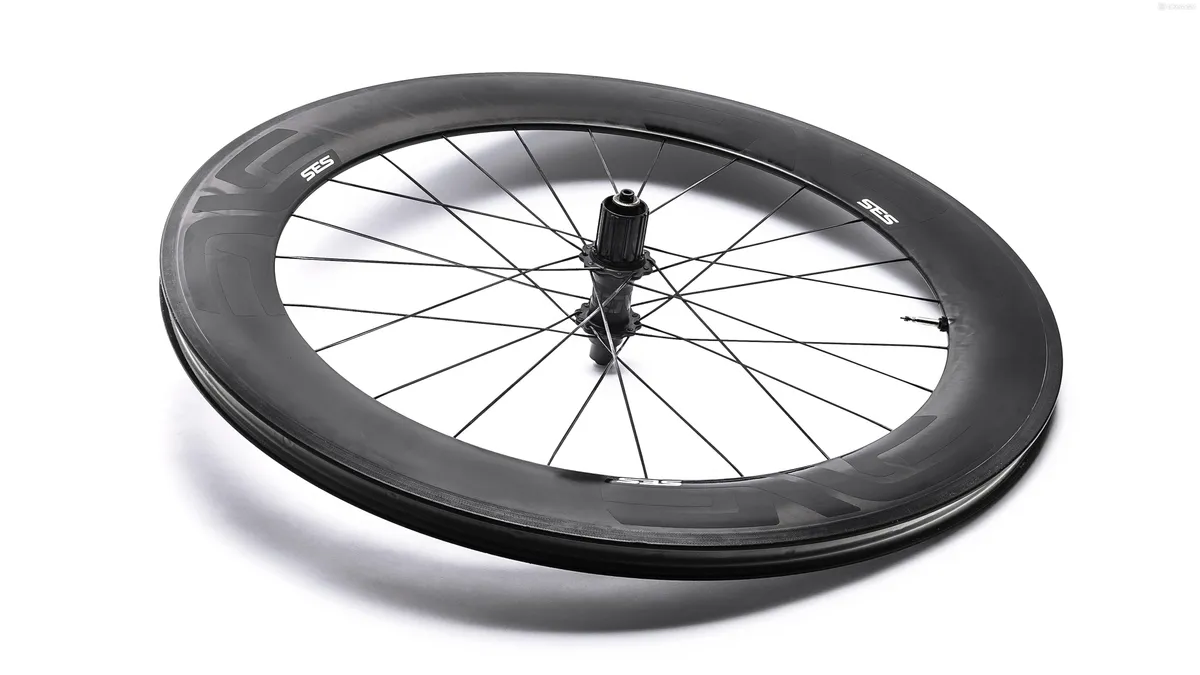
- Price: £3,100 / $2,700 / AU$TBC
- Weight: 1,696g
The super-wide 7.8 replaces the 6.7 and 8.9 in Enve’s range. Those are big shoes to fill but the 7.8 crushed this test.
It was the fastest at both angles in the wind tunnel and it feels it on the road. What’s more, its stability and braking set new standards for deep carbon wheels; the former is astonishing for a 71/80mm wheelset so you’re never afraid to ride it even when the flags are straight.
The new machined brake tracks require a little pad toe-in and then deliver very strong and progressive dry braking, and excellent wet braking with almost zero delay before the pads bite.
They’re stiff and light, too. 25c tyres align perfectly and aren’t too much of a struggle given that the 7.8 is tubeless ready. Enve’s own carbon hubs rocket the price; they’re £3,100 on the cheaper R45 hubs and £3,500 on Enve hubs.
Verdict: Outstanding. The best speed, stability and carbon braking. A new benchmark, at a price.
Zipp 808 NSW
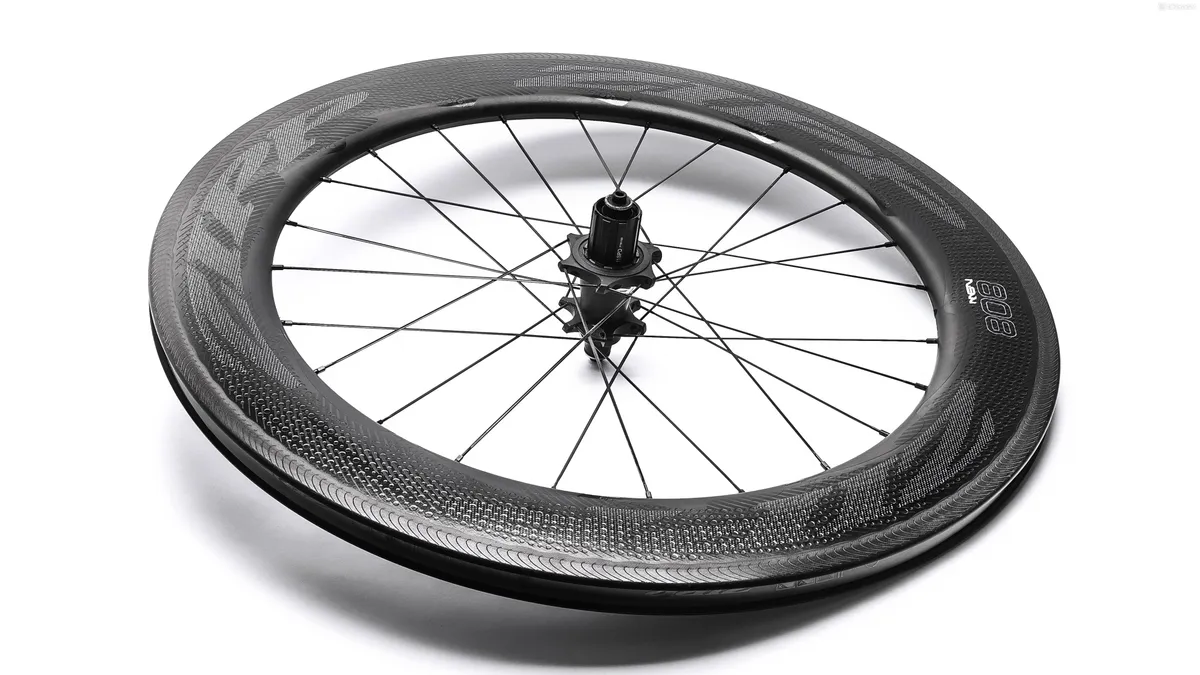
- Price: £2,350 / $3,400 / AU$TBC
- Weight: 1,795g
This old dog has learned some new tricks. The familiar 82mm depth is retained but the NSW generation 808 gets a revised profile that’s claimed to be more stable and slightly faster, new dimple patterns and laser graphics so they aren’t covered by decals, new grooved brake tracks, new carbon hubs and the clever Axial Clutch, which disengages the freehub when coasting to cut friction drag. The latter is noticeable in group rides and will add speed on descents.
The generous package includes bags, QRs, pads, extenders, tape and tubes. A 25c tyre sits perfectly and stability is very good, if not quite on par with the Enves.
High stiffness offsets some of the weight. In the wind tunnel they excelled at 5 degrees but were surprisingly slow at 12.5 degrees.
Verdict: High yaw test result hinders an otherwise fantastic wheelset full of clever tech.
HED Jet 6.9
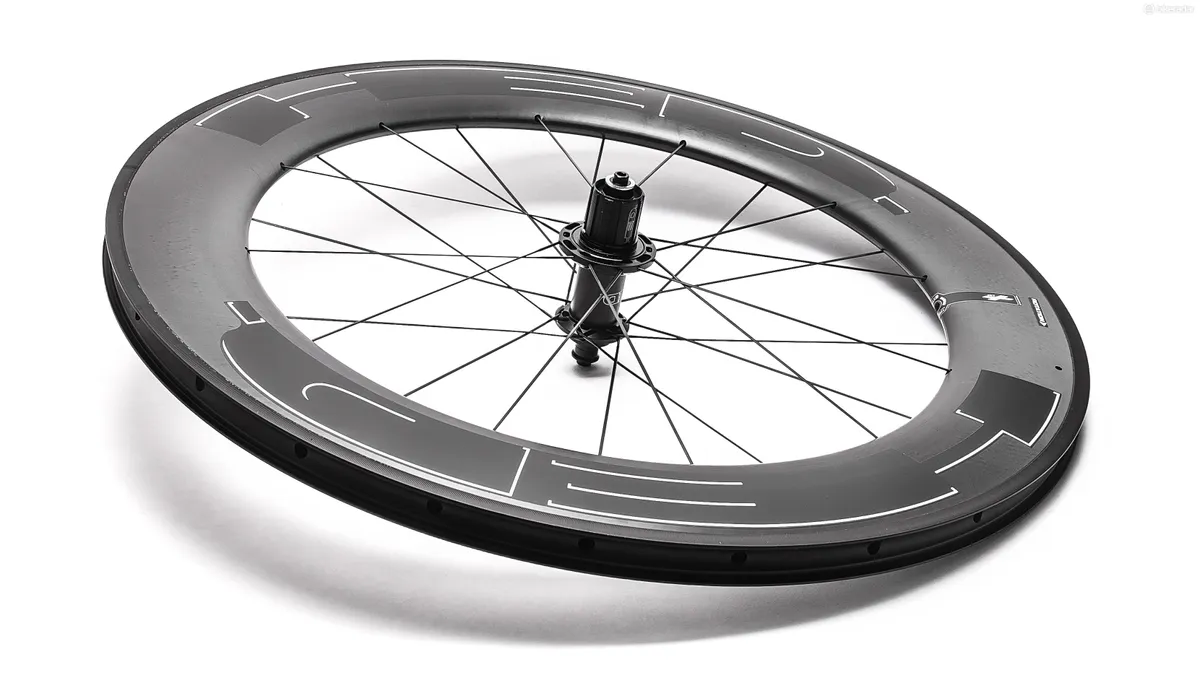
- Price: £1,600 / $TBC / AU$TBC
- Weight: 1,722g
That a HED wheelset places second only to the mighty Enves on overall aero performance, and fourth just behind the same on weight, is no surprise if you’ve been riding for long enough to remember the brand were aero pioneers; what really raises eyebrows is that this fast and light wheelset is a mixed depth 60/90mm combo and it has alloy rims.
The aero fairing is wafer-thin carbon fibre bonded to the rim, so it’s noisy and must be handled carefully. That mid-depth front and the highly developed shape means the Jets are super stable and the machined, anodised brake track produces stopping power to rival disc brakes.
They’re tubeless-ready, too, and they look particularly cool in a bike, so this is a very complete wheelset.
Verdict: Unrivalled value, very fast, top-level braking and stability.
Knight 95

- Price: £1,849 / $TBC / AU$TBC
- Weight: 1,896g
The deepest wheels on test have an excuse for being the heaviest at 1,896g, but to justify the weight they have to turn their depth into speed.
On the road it feels like they come alive above 25mph, greedily holding onto inertia, and that’s borne out in the tunnel where they ranked third overall on combined drag, just 1W behind the HEDs.
The 25c Michelins inflate to 26mm for an ideal alignment. The weight blunts acceleration but they’re stiff and amazingly stable given their vast area. An update to tubeless is coming but tyre fit is already tight.
Wet braking has the usual delay and then bites very well. The Aivee hub option brings the price down and makes the 95 one of the most affordable wheels designed with in-depth proprietary R&D, though higher spec hubs push them close to Zipp.
Verdict: Really fast, great value and more stable than you’d believe, but heavy.
DT Swiss 65 RRC
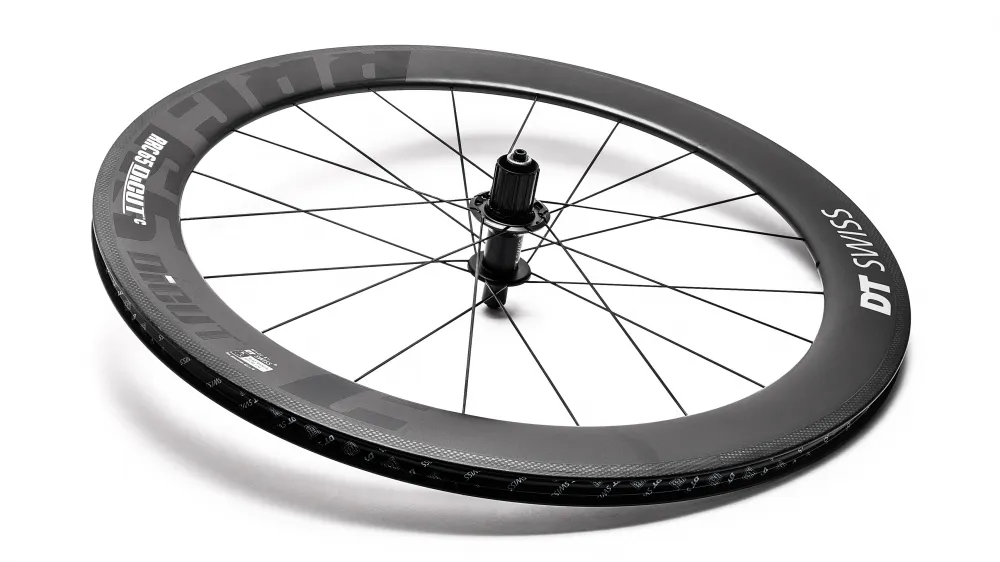
- Price: £2,000 / $3,090 / AU$TBC
- Weight: 1,659g
As one of the shallowest wheels on test, the 65 RRC punched above its weight in the wind tunnel, ranking fourth at 5 degrees and sixth at 12.5 degrees, albeit with drag closer to the wheels below it than above.
The tubeless-ready rim is narrower than most yet a 25c tyre inflates to 26.5mm. That’s wider than the wheel, so a 23 would likely suit it better and possibly make it faster.
Stability in the wind is decent, though lighter athletes or those entirely unused to deep-section wheels would be better served elsewhere. We have two issues with the 65 RRC: one is the very poor braking on both dry and wet roads, the other is the price.
These are decent wheels indecently priced. If they were £1,400 / $1,700 they’d have a place but they can’t handle the opposition at £2k.
Verdict: Weak braking and a high price spoil one of the faster wheels here.
Mavic CXR 80T
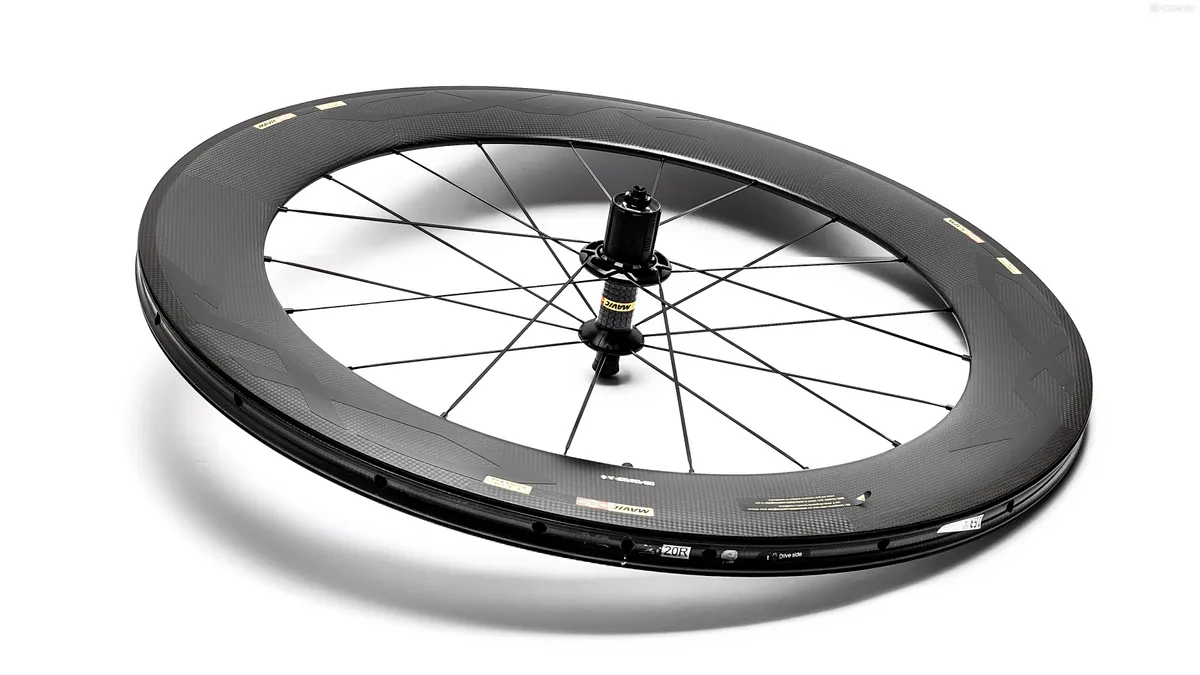
- Price: £2,050 / $2,899.90 / AU$TBC
- Weight: 1,723g
There are few tri-specific wheels but the clip-in ‘blades’ which perfectly smooth the transition from tyre to rim are a clever idea that isn’t legal for pro roadies.
The CXR 80 is now nearly four years old but it’s still a force. It’s tubular only and comes with Mavic’s specific tyre (which makes the price look better), the pattern of which is designed to influence airflow.
Grip and braking are good in the dry but almost entirely absent in the wet. We had a scary slide in a corner at 35mph and where most carbon wheels have a delay before braking arrives in the wet, with the CXR 80s it simply never arrives.
They’re stable and proved extremely fast at high yaw in the tunnel, but were bizarrely slow at low yaw.
Verdict: Fast and stable in crosswinds but terrible in the wet and low wind, and tub only.
Vision Metron
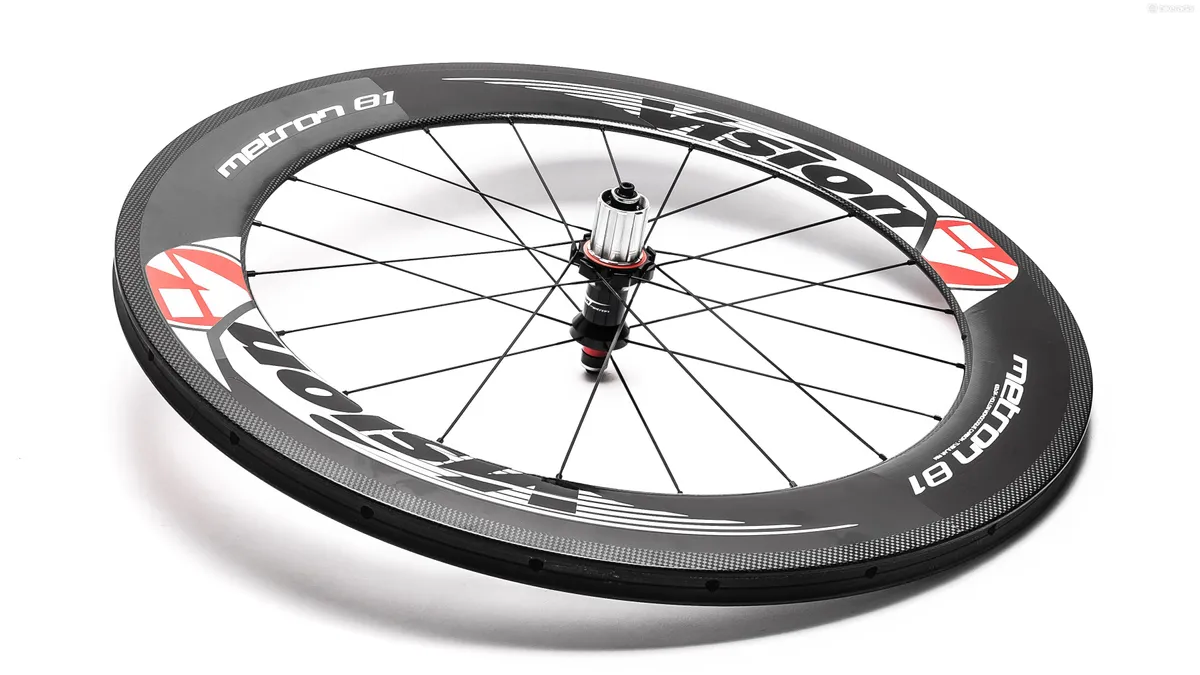
- Price: £1,749 / $TBC / AU$TBC
- Weight: 1,823g
The wheels pictured are 81mm tubs because the test set of 55/81 clinchers were already in testing and unavailable for the studio.
While the tubs are lighter and the deeper front might be faster, the mixed set is a lot more appealing.
The 55 front is stable even for its depth and so offers an advantage over all but the Enves and HEDs.
Rear wheels don’t affect stability so the big 81 in the back makes sense to add speed. On the road they feel quick but not on the pace of the best and the tunnel backed that up with a solid mid-table placing.
They’re a bit heavy and braking is only okay but the price mitigates that. If you’re on a budget and concerned about riding deep wheels on less than calm days, these are worth a look.
Their main problem is that everything they can do, the HEDs can do better and for less outlay.
Verdict: Good value and stable but heavy and not super-fast.
Profile Design Twenty-Four 78
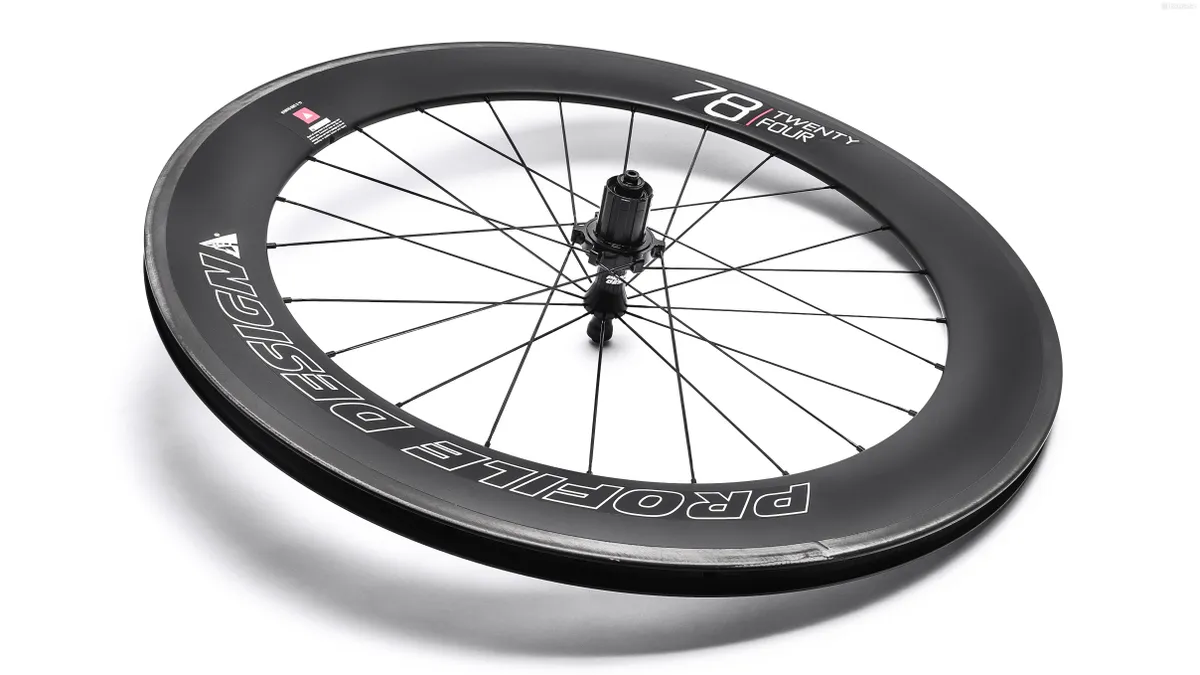
- Price: £1,800 / $TBC / AU$TBC
- Weight: 1,884g
The odd name refers to the width and depth of the tallest rim in Profile Design’s new generation. Our control tyre inflated to 26.5mm, bigger than the rim, so a 23 would likely suit better.
The 78 never felt especially fast on the road and was even more disappointing in the tunnel, where it ranked seventh on combined drag ahead of only the duds.
The stiffness is good and the stability is impressive, echoing our experience of the 58mm version, but the substantial weight tells and they often feel sluggish.
While the dry braking is okay, in the wet it’s abysmal. The price might make them look appealing but the HEDs and Knights blow them into the weeds and a very good set of free tyre levers isn’t enough to rescue the 78 from being ordinary.
Verdict: Unremarkable in most ways except the wet braking, which is remarkably bad.
Roval CLX 64
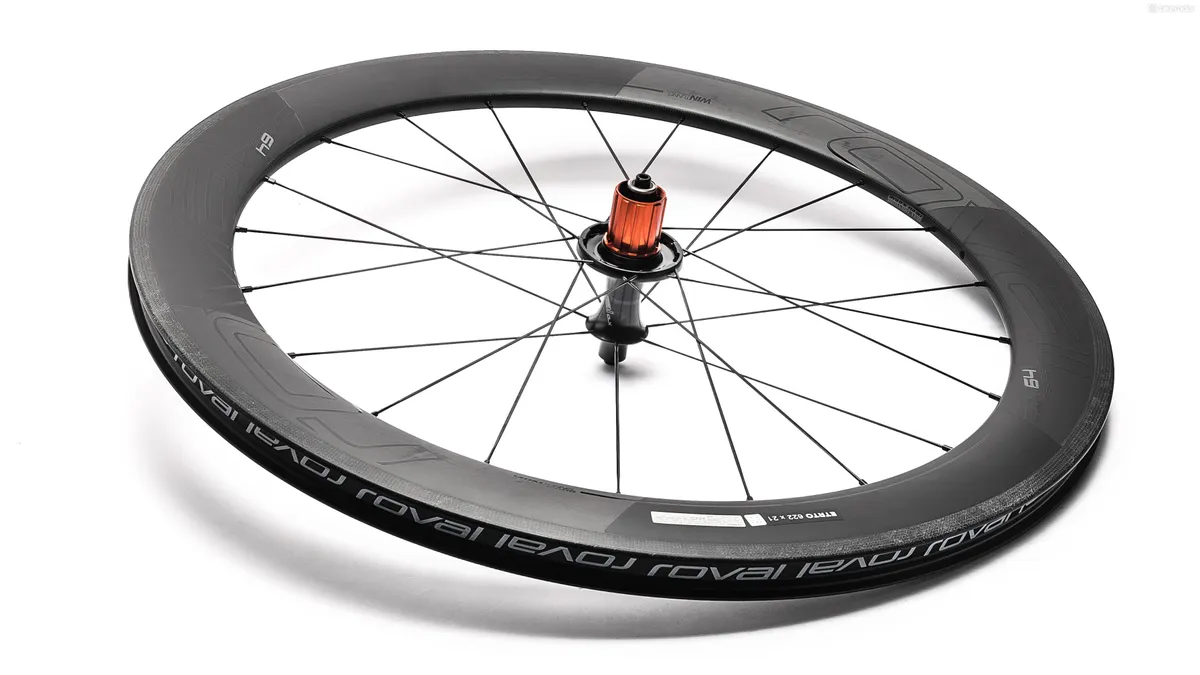
- Price: £1,770 / $2,400 / AU$TBC
- Weight: 1,596g
You think you’ve seen wide rims, and then there’s the CLX 64 which required half-worn pads to fit in our Orbea’s TriRig calipers and pushed the 25c tyre out to 29mm when inflated.
We’d hypothesise that this extra frontal area is to blame for the woeful performance in the wind tunnel but it didn’t hinder the HEDs.
On top of that, the CLX is sorely lacking stability in windy conditions. The Rovals are the lightest on test but they only feel it in your hands and not in the bike because there’s so much flex that brake rub is a constant companion even during light efforts out of the saddle.
At such times the impressive braking, the best of the non-machined carbon rims, becomes a double-edged sword. Still, the tyre fit is easy for a TLR rim.
Verdict: Slow, twitchy and flexy. The imminent replacement can’t come soon enough.
Progress Space 88

- Price: £1,495 / $TBC / AU$TBC
- Weight: 1,745g
Progress is a Spanish brand that so far has focused its R&D efforts on construction over aerodynamics. This 88mm rim uses an old-school V-shape profile yet features basalt brake tracks and a titanium insert in the rim to boost impact strength.
If you do manage to damage them within the first year, Progress offers 50 percent off a replacement. The stiffness is decent and the braking is actually pretty good but then it all falls apart.
These wheels were slow in the tunnel and downright frightening on the road, with a level of instability even in light wind that made them almost unrideable.
Progress has a new U-shape rim coming very soon and they say it will be much more stable. We’ll be testing a set when we get hold of them.
Verdict: Good braking but slow and shockingly unstable. Avoid.
Conclusion — the best deep aero wheels are...
After the most exhaustive testing we’ve ever done, the group of 10 wheelsets split into two halves. At the bottom, the ridiculously unstable and slow Progress 88 is one of the worst wheels we’ve tested and its replacement can’t come soon enough.
The Roval is also really disappointing, while the Profile Design, DT Swiss and Mavic merely failed to impress.
The Vision Metron 55/81 combination is much better. The performance doesn’t sparkle but they’re more affordable than most and a good buy.
We can’t split the Knights and Zipps so they’re tied for third. The Knight 95s were a fraction faster in our tests and they’re usefully more affordable; the Zipps are better built and offer stronger braking with lower weight and more in the package (plus a famous name if that matters to you) — if you can afford them, they’re worth the extra.
The HED Jet 6.9 is a strong and deserving runner-up, and a no-brainer for best value. The braking and price are great because it uses an alloy rim, it’s stable because of the mixed depth and refined shape, and fast because HED really knows its stuff. That it’s also light is amazing — that combination shouldn’t be possible. Buy with confidence.
It took something special to beat them. The Enve 7.8 is that special wheelset. It took a thumping win — fastest in the wind tunnel at both angles, third lightest behind two mid-depth wheels, the best carbon braking and the most stable. On top of that it’s TLR, has a great warranty and is offered in more affordable builds. This version with Enve’s carbon hubs is our top pick, the 7.8 on Chris King R45s should be everyone else’s.
Combined drag
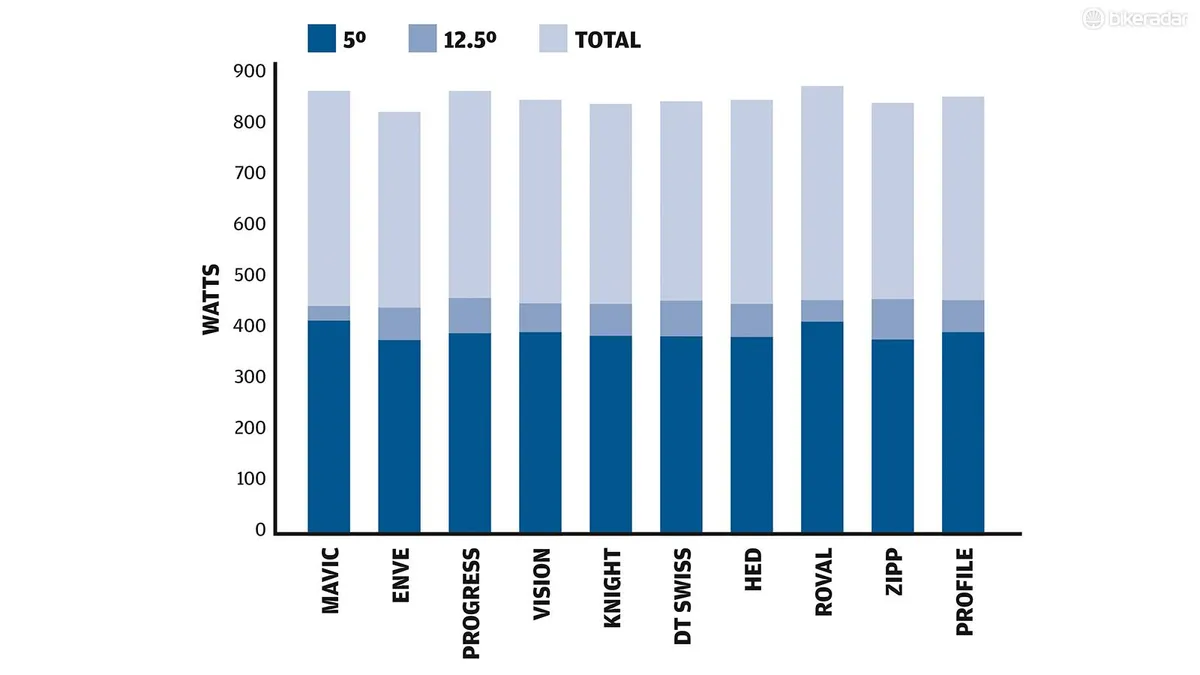
What the data means
This graph shows aero performance at 5-degree and 12.5-degree wind angle. Lower numbers are better. Now, here comes the science bit.
The wind tunnel measures drag as a force in Newtons. The boffins at the University of Southampton then convert this figure into the power (supplied to 0.0001W but rounded here to the nearest whole watt) required to sustain 30mph for our test rider with his position, skinsuit, helmet and bike.
With the wheels the only difference, comparing these power numbers shows you the relative speed of each wheel.
Broadly speaking, 10W is worth around 1s/km, so there’s up to two minutes to be saved in a 40km bike leg between the best and worst of these wheels, and even the slowest of these is much faster than a basic alloy training wheel.
The power figures in our results graph are higher for the greater 12.5-degree wind angle because the drag of the total bike and rider system is higher, even though the contribution of the wheels is smaller.
To learn more about why deep-section aero wheels are faster, check out Why are deep-section aero wheels faster? on our sister site, 200Triathlon.com.
Thanks to...
Michelin for supplying the new Power 4 Competition clincher as a control tyre. This was our first experience of this tyre and it impressed us a lot. It feels fast, grips well in both wet and dry and we only had one puncture. The 25mm tyre inflated to a neutral round shape which made for a fair test. Other versions of the Power 4 are also available.
Prestige Cycles for kindly setting up the wind tunnel test for us. Prestige run aero set-up sessions for triathletes at the University of Southampton plus bike fit clinics in store. They have recently become the UK agent for Dimond tri bikes alongside a range of bespoke road bikes.